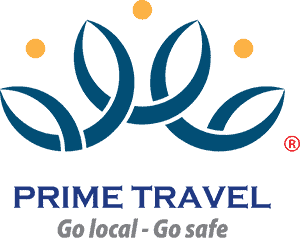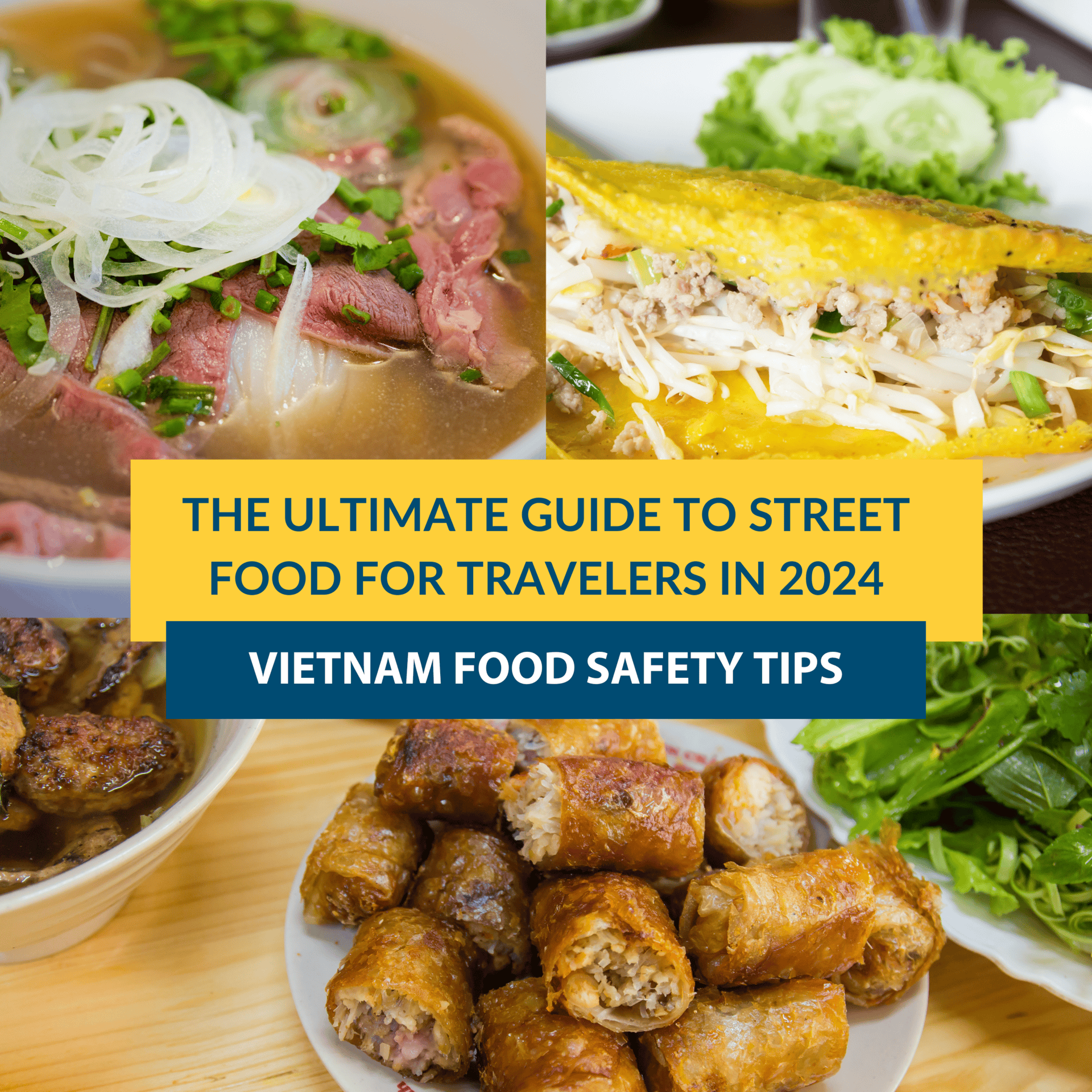
Vietnam Food Safety: The Ultimate Guide to Street Food for Travelers in 2024
Discover essential tips on Vietnam food safety with Prime Travel to ensure a hassle-free trip and fully enjoy your journey. Vietnamese street food is not just a culinary delight, it’s a window into the heart of the country’s culture.
When travelers want to experience the cuisine of a new and unfamiliar country, they often wonder whether every food stall offers both delicious and hygienic options. To avoid food poisoning and enjoy diverse culinary offerings safely, follow these essential Vietnam food safety tips.
Vietnamese Street Food Culture
Overview
Street food in Vietnam has roots in ancient times, where food vendors played an essential role in providing quick, affordable meals. Over centuries, street food became ingrained in daily life, with each region developing its own signature dishes.
- Diversity of dishes: Vietnamese street food is rich with a variety of dishes from North to South. Each region has its own specialties, from “pho” and “bun cha” in the North, to “mi quang” and “bun bo Hue” in the Central region, and “com tam” and “hu tieu” in the South. This diversity reflects the cultural and ingredient variety in each area.
- Cultural exchange: Street food is not just about the dishes; it’s also a place for locals and tourists, creating opportunities to share experiences and stories about cuisine and customs.
- Public spaces: Street food stalls are usually located in convenient spots like along the streets, at market corners, or in parks, creating a friendly and inviting atmosphere. This makes it easy for everyone to access and enjoy a meal in a relaxed setting.

Guide to Vietnamese Street Food: Sidewalk dining culture (Source: Internet)
- Creativity in Cuisine: Street chefs often bring their own creativity to food preparation. They frequently experiment with ingredients and spices to create unique dishes, keeping the dining experience fresh and exciting for customers.
- Affordable prices: Street food attracts both tourists and locals due to its affordability. You can enjoy a variety of delicious dishes for an average price of 20,000 to 60,000 VND (about 1 to 3 USD) per dish. However, specialty items or those in popular tourist areas may cost between 70,000 to 100,000 VND (3 to 4 USD).
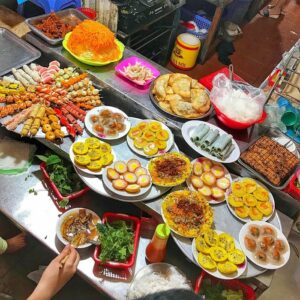
Guide to Vietnamese Street Food: Banh Trang Nuong, Banh Khot (Source: Internet)
Read more>>>Top 5 best Vietnamese traditional food that you must try
Risk of Street Food in Vietnam Regarding Food Safety
Here are potential issues travelers may face when eating street food in Vietnam:
- Hygiene and Sanitation: Street food stalls may not always adhere to the same strict hygiene standards as formal restaurants. This could lead to issues like improper food handling, unclean cooking surfaces, and contaminated water.
- Foodborne Illnesses: Due to these factors, there is an increased risk of foodborne illnesses like E. coli, Salmonella, and Hepatitis A.
- Digestive problems: Travelers unfamiliar with local cuisine might experience digestive issues due to different spices or sudden changes in diet. While the spices and condiments used in Vietnamese street food are often delicious, some may be too strong for those with sensitive stomachs.
- Lack of Proper Storage: Improper storage of food can also contribute to bacterial growth and food spoilage.
- Unregulated Ingredients: Some street food vendors may use ingredients of unknown quality or origin, which could be contaminated or expired.
How to Choose the Best Street Food Stalls in Vietnam
When navigating the street food scene, it’s important to have a strategy. Whether you’re prepared with recommendations or choosing places spontaneously, there are some simple ways to find the best vendors.
Choosing places with several sign
- Busy stalls: A high volume of customers can indicate that the stall has been established for a long time, suggesting that locals frequently visit and trust the food quality. This long-standing patronage often reflects the stall’s reputation for serving delicious dishes that keep customers coming back for more. These popular spots typically experience higher food turnover, meaning dishes are cooked more frequently, ensuring freshness.
- Cleanliness: Pay close attention to the hygiene of the stall and its surroundings. A well-organized and clean setup suggests that the vendors care about their food handling practices and take pride in their work.
- Visibility: Finally, opt for stalls that are spacious and well-lit. Good visibility allows you to observe the food preparation process, helping you avoid darker and cramped.
Read more>>>Hanoi Street Food: Top 10 DELICIOUS dishes You Can’t Miss
Ask locals for recommendations
One of the most effective ways to ensure Vietnam food safe experiences, while still enjoying your meals, is to ask locals for their favorite dining spots. Engaging with your tour guide, hotel staff, or even friendly locals can lead you to some of the best places to eat.
Don’t hesitate to strike up a conversation; many people are happy to share their recommendations. You can also inquire about any specific dishes that are particularly popular or well-reviewed. This local knowledge not only enriches your dining experience but also allows you to discover unique flavors and culinary traditions.
Looking on social media
Social media platforms like Facebook, Instagram or Youtube can serve as excellent resources for discovering highly recommended food stalls in Vietnam. By exploring these platforms, you can create your own guide to Vietnamese street food. Many food enthusiasts and travelers share their experiences and recommendations online, often tagging their favorite spots and posting photos of the dishes they enjoyed.
By browsing relevant hashtags or joining local food groups, you can gather a wealth of information about the best street food vendors. Additionally, checking for recent reviews or comments can provide insights into the quality and suitable price of the food.
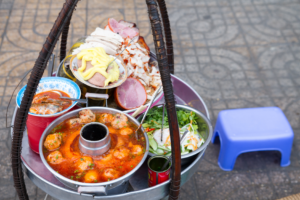
Vietnam food safe: Sidewalk street vendor (Source: Internet)
Some Hidden Gems in Narrow Alleys
One special feature often highlighted in any guide to Vietnamese street food is that many of the best stalls are tucked away in narrow alleys or hidden lanes. These spots often offer delicious dishes that aren’t widely known, typically frequented only by locals who are familiar with them.
The paths leading to these stalls can be narrow and winding, but once you step inside, you may be surprised by the spacious and airy atmosphere.
You’ll often find a bustling crowd, with the owners and staff working tirelessly to serve customers. These hidden gems not only provide exceptional food but also allow you to experience the authentic essence of Vietnamese cuisine.
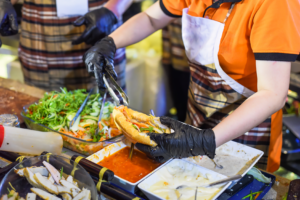
Vietnam food safe: Banh my (Source: Internet)
How to Avoid Food Poisoning: Vietnam Food Safety Tips
The question “How to avoid food poisoning in Vietnam while indulging in street food?” is a major concern for many travelers. But with a few precautions, you can minimize your risk.
Pack Essential Medications
Include medications such as stomach pain relievers, anti-diarrheal medication and digestive enzymes. Having these on hand can help manage any stomach issues that may arise while trying new foods. Consider packing a small first-aid kit for any minor injuries or reactions.
Avoid raw, uncooked food
Always opt for food that has been freshly cooked and avoid raw or undercooked items like raw seafood or uncooked vegetables, as their cold nature can provide an opportunity for bacteria to thrive and multiply. Cooking kills harmful bacteria and pathogens that can cause foodborne illnesses, ensuring your meal is safe to eat. If you prefer not to eat raw vegetables and would like them blanched instead, you can ask the vendor for “rau tran”.
Water safety
In Vietnam, water safety is a crucial consideration for travelers. Tap water is not safe to drink, so it’s essential to always carry bottled water during your trip. When purchasing bottled water, stick to well-known brands, as they are more likely to meet safety standards such as Dasani, Lavie, Aquafina, TH true water…
Ice
Use your own judgment regarding ice. Avoid ice at small street stalls, but it may be acceptable at larger, reputable places. Ice can be contaminated if not made from safe water, and reputable establishments are more likely to have safe practices.
Vegetables and fruits
Limit raw vegetables and choose blanched or cooked options to eliminate harmful bacteria. For fruits, always peel the skin before eating, as it can carry pesticides and bacteria. These simple steps can help reduce the risk of ingesting harmful substances and making them safer to eat.
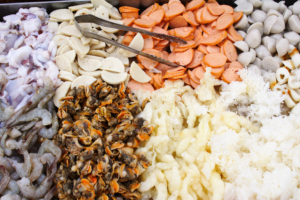
Avoid food poisoning: Raw, uncooked food (Source: Internet)
Read more>>>Top 12 most underrated dishes in Vietnam – Eat like locals
Avoid Wild Animals
Do not consume dishes made from wild animals (e.g., soft-shell turtles, snakes, or field rats). Wild animals may carry serious diseases that can be transmitted to humans through consumption. For example SARS from civet cats and Ebola from fruit bats. To avoid food poisoning and reduce the risk of illness, it’s best to steer clear of these foods.
Visual check
Before ordering, visually inspect the vendor’s stall. Clean utensils, covered food, and hygienic preparation areas are all signs that the vendor takes food safety seriously. If something looks off, it’s best to walk away.
Hand & utensil hygiene
Street food can be eaten with your hands, so it’s crucial to keep them clean. Carry hand sanitizer or hand gel and use it before and after meals. Washing your hands with soap when possible is even better.
Ensure that utensils, plates, and bowls are clean and dry before use. Wet utensils may harbor bacteria, so using clean and dry items minimizes the risk of contamination, hence, avoid food poisoning.
Allergy awareness
If you have food allergies, be cautious. When ordering dishes that include various ingredients, confirm with the staff whether the meal contains any allergens you need to avoid. You can also inform the staff about your allergies so they can exclude those ingredients during preparation.
Many street food dishes contain peanuts, shellfish, and soy, so always double-check with the vendor. Communication can sometimes be a barrier, so learn some Vietnamese words for your specific allergies.
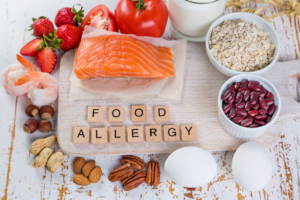
Avoid food poisoning: Food allergy (Source: Internet)
What to Do if You Experience Food Poisoning
Sometimes, despite all precautions, food poisoning can happen. Here’s what to do if you find yourself feeling unwell after eating street food in Vietnam.
Immediate actions
The first symptoms of food poisoning typically include nausea, diarrhea, and stomach pain. Drinking enough water is important to avoid dehydration, especially if you’re feeling sick with nausea or vomiting. These symptoms can make you lose a lot of fluids and leave you feeling tired. In this case, using oral rehydration salts can help replace lost electrolytes and give your body some energy.
Keep a record of what you ate and when symptoms began to help identify the source. Staying hydrated with electrolyte drinks can help restore your energy and get you back to feeling normal again.
Seek medical assistance
If symptoms worsen or last more than a day, it’s important to seek medical help. Vietnam has numerous clinics and hospitals with English-speaking staff, especially in major cities. Be sure to have your travel insurance details ready in case of emergency.
It’s also a good idea to carry any necessary medications with you, as some may not be readily available in local pharmacies. If you’re on a tour, ask your guide for assistance in locating the nearest medical center, and always keep a list of local emergency contacts on hand for quick reference.

Avoid food poisoning: Healthcare services for foreigners (Source: Internet)
After experiencing food poisoning
Avoid eating heavy foods for a few days as your stomach might need time to heal, you can focus on bland options like rice and toast. Drink plenty of water to stay hydrated. Lastly, take time to rest and recover fully before continuing your travels.
Read more>>> Medical & Health
Recommended Vietnam Safety Food Tours
Are you eager to explore a food tour featuring delicious spots known only to locals? Do you want to enjoy Vietnamese street food tailored to your tastes and still maitain safety?
At Prime Travel, we have food tours that meet all your criteria. Safety is our top priority when designing any tour, allowing you to indulge in authentic cuisine without concerns. You won’t have to navigate on your own or search for restaurants; our guide will lead you every step of the way. With Prime Travel, your dietary preferences and personal tastes will be considered to customize the tour.
Take a look at our two special food tours below and the only thing you need to do is choose your favour ones:
Walking Street Food Tour – Hanoi
Discover local street food vendors, family-run restaurants, and a wide range of Vietnam traditional foods beyond typical street food.
- Duration: 3 hours
- Start time: Lunch option (11:15 – 11:45 AM) or Dinner option (05:45 – 06:15 PM)
- Signature Dishes: Enjoy famous Vietnamese foods like pho, banh mi, and egg coffee, along with other dishes tailored to your preferences, as our guide will recommend options that best suit your tastes.
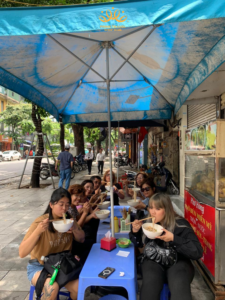
Guide to Vietnamese street food: Walking street food tour in Hanoi (Source: Prime Travel)
For foodies and cultural enthusiasts alike, this tour offers an immersive experience that showcases the stories and traditions behind every dish. As you savor the flavors that make Hanoi a top culinary destination, you’ll also explore hidden gems along the way, from bustling markets to tranquil temples, gaining a deeper understanding of the city’s rich culture and history.
Dinner with Local – Hanoi
The best way to truly experience local culture is by dining with locals in their cozy homes. Enjoy home-cooked meals, share daily life stories, and gain valuable insights into the local way of life for a memorable evening.
- Experience authentic Vietnamese hospitality in a charming house, often designed with a unique blend of modern and traditional architecture
- Hand-in a short cooking demo to make traditional Vietnamese dishes, using fresh, locally sourced ingredients.
- Gaining insight into local traditions, customs and daily routines through meaningful conversation with the host family

Guide to Vietnamese street food: Dinner with local (Source: Internet)
For travelers looking to immerse themselves in Vietnamese culture and enjoy home-cooked, authentic dishes that are hard to find elsewhere, this tour offers a unique opportunity to experience local life firsthand. You will dine with a local family and gain a deeper understanding of daily life in Vietnam, all while enjoying the warm hospitality and unique atmosphere of a traditional Vietnamese home.
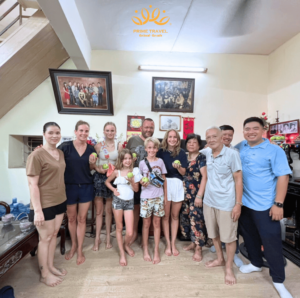
Guide to Vietnamese street food: Dinner with local (Source: Prime Travel)
Read more>>>Dinner with Local Tour
Conclusion
Exploring a country’s cuisine safely is essential for a fulfilling travel experience. Vietnamese street food is celebrated for its rich flavors and unforgettable taste, leaving a lasting impression on all who try it. By keeping a few precautions in mind, you’ll enjoy a safe and flavorful journey through Vietnam’s dynamic food culture. Immerse yourself in the tastes, savor every bite, and make your trip truly memorable. Ready to taste the best of Vietnam? Contact Prime Travel right now to have your own adventure.
Read more>>>
What makes Cafe in Hanoi most unique and special 2023?
Top 7 Best Vegetarian Restaurants Hanoi that you MUST TRY
